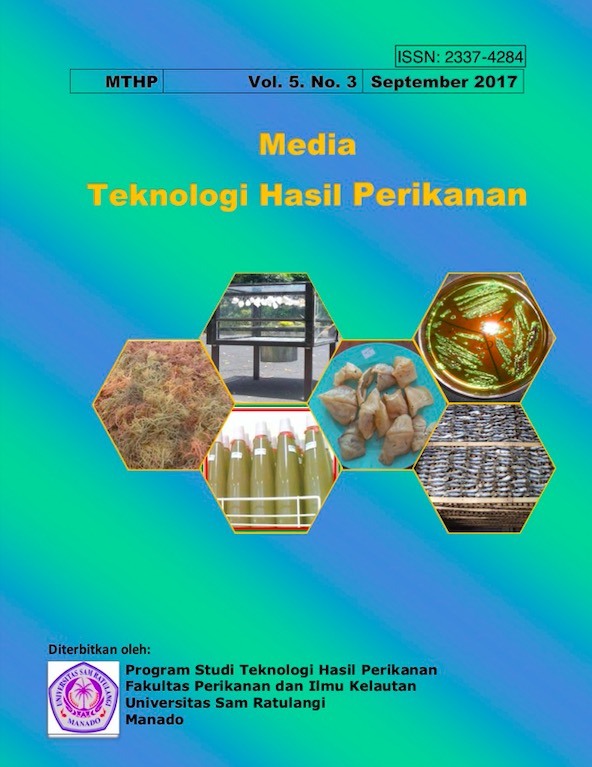PENANGANAN IKAN NILA (Oreochromis niloticus) HIDUP DENGAN DENGAN MENGGUNAKAN ES SEBAGAI PENGAWET
DOI:
https://doi.org/10.35800/mthp.5.3.2017.16849Keywords:
Teknik handling, Aerasi, Pemingsanan, Penyimpanan, Penyadaran dan MortalitasAbstract
Imotilization of fish is one way of handling techniques by using low temperature (cooling). Cooling (cold chain) is applied to transport live fish so that the weight of the load during transportation could be reduced and fish do not experience stress during transportation. This technique is more advantageous when compared with the wet transportation system by using water. After the fish fainted, fish could be re-awakened by returning the fish to the pond with the aid of sufficient aeration to facilitate fish regain consciousness. This study aims to determine the rate of stunning, the speed of awareness, and mortality of nile tilapia fish which was treated and stored at different temperatures and times. This study used a factorial completely randomized design (RAL) with 2 treatments namely, storage method (A) treatment consisting of 2 storage levels (Temperature 10-12 ° C and 14-16 ° C); and storage time (B) consisting of 4 levels (2, 4, 6 and 8 hours). The optimum time of fainting fish is at a temperature of 14-16 ° C that is 8.19 min. For re-awakening, the optimum time is 48 seconds when fish was stored for 2 hours. The best mortality rate was achieved at storage temperature ± 14-16 ° C because after 6 hours storage the mortality rate was only 20.8%, but by the maximum storage (8 hours) the mortality has reached 87.5%, Meanwhile at a storage temperature of ± 10-12 ° C, the mortality has reached 50% after 6 hours and 100% at 8 hours.
Pemingsanan ikan merupakan salah satu cara teknik penanganan dengan pengunaan suhu rendah (pendinginan). Pemingsanan dengan suhu rendah diaplikasikan untuk transportasi ikan hidup dengan tujuan mengurangi berat beban selama transportasi dan supaya ikan tidak mengalami stress selama transportasi. Teknik ini lebih menguntungkan jika dibandingkan dengan transportasi sistem basah dengan menggunakan air. Setelah dipingsankan ikan kembali disadarkan dengan mengembalikan ikan ke kolam air habitatnya dengan dibantu aerasi yang cukup agar ikan kembali sadar. Penelitian ini bertujuan untuk mengetahui kecepatan pemingsanan, kecepatan penyadaran, dan mortalitas ikan nila yang dipingsankan dan disimpan pada suhu dan waktu berbeda. Penelitian ini menggunakan rancangan acak lengkap (RAL) faktorial dengan 2 perlakuan yaitu, perlakuan metode penyimpanan (A) yang terdiri atas 2 taraf penyimpanan (Suhu 10–12°C dan 14–16°C); perlakuan lama penyimpanan (B) yang terdiri atas 4 taraf (2, 4, 6 dan 8 jam). Waktu optimum kecepatan pingsan adalah pada suhu 14–16°C yaitu 8,19. Untuk penyadaran kembali, waktu optimumnya adalah 48 detik, pada ikan nili yng disimpan 2 jam. Pada penyimpanan suhu ±14-16°C didapat tingkat mortalitas terbaik karena sampai penyimpanan 6 jam tingkat mortalitasnya hanya 20,8%, namun sampai penyimpanan maksimum ( 8 jam) sudah mencapai 87,5%, sedangkan pada suhu penyimpanan ±10-12°C , setelah 6 jam mortalitasnya sudah mencapai 50% dan saat 8 jam tingkat mortalitasnya sudah mencapai 100%.
Downloads
Published
How to Cite
Issue
Section
License
Authors who publish with this journal agree to the following terms:
- Authors retain copyright and grant the journal right of first publication with the work simultaneously licensed under a Creative Commons Attribution License that allows others to share the work with an acknowledgement of the work's authorship and initial publication in this journal.
- Authors are able to enter into separate, additional contractual arrangements for the non-exclusive distribution of the journal's published version of the work (e.g., post it to an institutional repository or publish it in a book), with an acknowledgement of its initial publication in this journal.
- Authors are permitted and encouraged to post their work online (e.g., in institutional repositories or on their website) prior to and during the submission process, as it can lead to productive exchanges, as well as earlier and greater citation of published work (See The Effect of Open Access).







